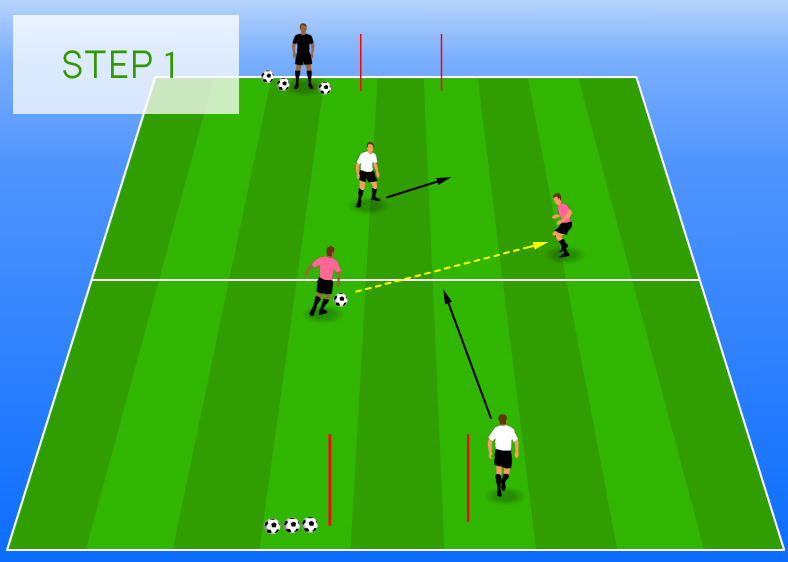2v1+1 Recovery Practice
- Author: Ian Knapp
- Age Group: U10 to U17+
- Time: 20 minutes
Introduction:
This is a good starter practice for introducing defending when outnumberd, with a focus on the basic role of both the outnumbered player and a recovering player.
Setup:
- Set up several areas about 18 x 12 yards, but this should be judged on the age and ability of your players. Several so that you can involve everyone and run the same practice a number of times at the same time.
- Goal at each end using poles or cones. When starting out, make the goals quite small - as the players get better at defending the goal, you can make them bigger and even add a goalkeeper.
- Split players into pairs.
- One pair are defending and one attacking.
- The defending pair start with one player just in front of their own goal and one player next to the opposition goal.
- The attacking team start with the ball at their own goal.
- Coach at side with more footballs.
- If you don’t have a number of players divisible by 4, players will have to take turns.
Basic Rules:

- The attackers must try to score in the opposite goal to where they start.
- The defender already on the pitch must try to stop them.
- The recovering defender can start tracking back once the ball crosses the half way line (or when the coach tells them they can).
- If the defenders win the ball, they can try and score at the other end.
- Once ball is out or a goal is scored, switch roles and the defenders become the attackers.
- Repeat. Keep score. Winners after a certain number of turns (best of 5) or a time period.
- If multiple practices set up, switch pairs between pitches periodically to give everyone a chance to play against each other.

In the above images, we show how the white defender has effectively held up the play to give his team mate a chance to recover and help, turning the situation into a 2v2 and giving pinks much less chance of scoring.
5 Key Coaching Points:
- Delay - your job is to hold up the attackers so that your team mate can get back and help you.
- Positioning - protect the goal, but don't get too close to the attacker with the ball or he/she will just pass to their team mate. See "Step 1" above for a good position for the outnumbered defender to be in.
- Don't dive in - if you try to win the ball too agrressively, you leave yourself open to the attacker either dribbling past you or passing to their team mate for an easy goal.
- Recovering player - angle and speed of recovery run. This might vary depending on where they are starting from and where the ball is. If they can win the ball then brilliant. If not, can they recover to a position that provides cover to allow the outnumbered defender to press the ball?
- Communication - work as a unit and if you have a goalkeeper in the practice, encourage them to communicate too.
There are coaching points for the attackers too, but we're focusing on defending here, so rather than confusing the issue, we'll leave them out here.
Coaching Points (FA's 4 Corners):
| Technical | Psychological |
|---|
- Delay - your job is to hold the attackers up to allow your team mate to recover.
- Positioning - block the goal but don't get too close to the player with the ball - you need to be able to shift across if they pass.
- Body shape - not flat - keep side on - we need to be able to move backwards with the play to keep our positioning.
- Don't dive in - you don't have to win the ball.
- Recovery player - angle and speed of run (do you try to win the ball or try to get into a covering position to allow your team mate to try to press the ball).
|
- Decision making - what position do you take up to best protect the goal AND cover chance of a pass to the other player?
- Decision making - recovery player - do you try to win the ball or get back and cover for your team mate?
- Concentration - where is the goal? Can we make sure we keep it covered?
- Anticipate the attacker's next move based on their body shape and movement.
- Confidence to go again if you were beaten last time.
|
| Physical | Social |
|---|
- Speed, fitness, strength to keep pace with the attackers and not let them go past.
- Balance and agility to tackle, recover and block.
|
- Communication
- Working as a team
- Encouraging others
- Have fun!
|